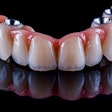A team of researchers at the Institute of Biotechnology of the University of Helsinki has developed a computer model reproducing population-level variation in complex structures such as teeth and organs. The research takes a step toward the growing of correctly shaped teeth and other organs.
The results were published online March 10 in Nature.
Jukka Jernvall, Ph.D., and his team have spent more than 15 years investigating the evolutionary development of mammal teeth. They have now compiled so much data that the main aspects of a formula for making teeth are beginning to be clear, they said in a press release.
In their most recent Nature article, they report a computational model of mammalian tooth development that combines parameters of genetic and cellular interactions to produce a 3D tooth from a simple tooth primordi. The model shows that regulation of tooth development is already well-known.
According to the model, a rather simple, basic formula seems to be behind the complex gene puzzle resulting in tooth formations, the researchers noted: The gene networks have a "patterning kernel" that regulates the variation of teeth among individuals in the same population. In addition, the variation of human teeth from the incisors to the molar teeth may result from a single factor regulating cell division.
The researchers tested their theoretical model, which is based on mouse tooth development, by investigating seal teeth. The Ladoga ringed seal collection of the Finnish Museum of Natural History at the University of Helsinki provided an ideal population sample for the research because dentitions are highly variable, according to Jernvall and his colleagues.
Their model may give new insights into the formation of organisms' 3D shapes, they added.
Copyright © 2010 DrBicuspid.com















